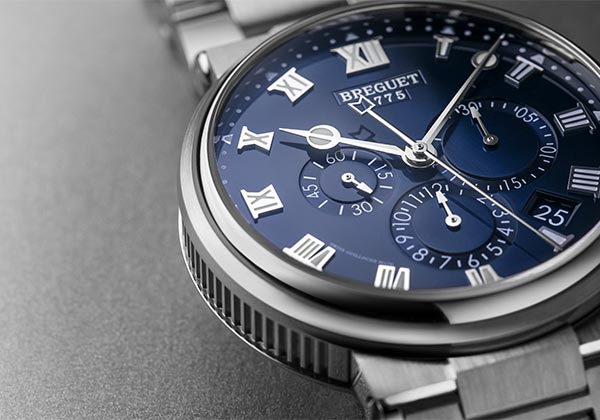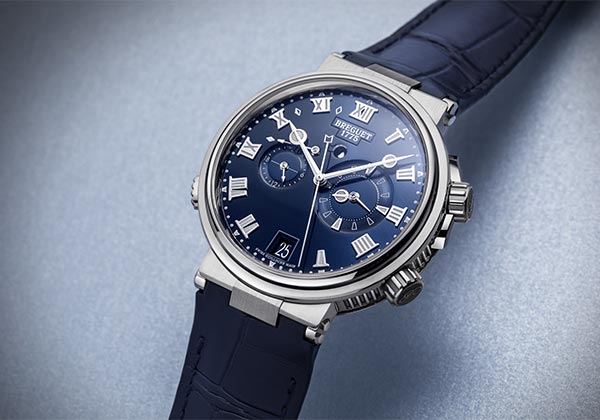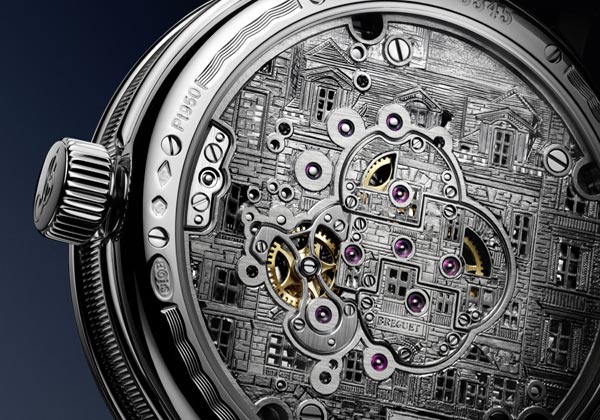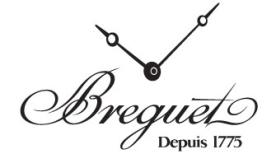Amid gentle waves or a big swell, in the eye of a storm or gliding over calm seas, it steadfastly holds its course towards the same horizons of precision, technical performance and sporting elegance. “It” is the Marine collection, enriched this year with three new sophisticated variations that continue to celebrate Breguet’s heritage in the realm of marine chronometry. The Maison’s longstanding relationship with the world of sailing has been cultivated ever since Abraham-Louis Breguet was appointed Watchmaker to the Royal Navy in 1815 by King Louis XVIII of France. At that time, marine chronometers were of paramount importance for fleets, as they enabled them to calculate the position of ships at sea. Regarded as full-fledged on-board instruments, they had to be as accurate as they were sturdy, especially in the rough conditions linked to ships’ constant movement. Held in high regard across European courts for his many watchmaking inventions, the founder of the House of Breguet was particularly renowned for developing exceptional marine chronometers mounted on a gimbal suspension system enabling them to maintain a stable horizontal position, regardless of the pitching or rolling of the ship.

Discovery, Escapism, Adventure
Two centuries later, Breguet continues its technical and aesthetic epic by enriching the Marine collection with three timepieces inspired by the spirit of discovery, escapism and adventure. The Marine 5517, 5527 and 5547 models are thus interpreted in versions featuring an assertive sporting character. What do they have in common? A case made of titanium, a material ensuring robustness, resistance to sea air and to corrosion. Not to mention incomparable lightness procuring optimal comfort on the wrist. The elegantly refined Reference 5517 features a three-hand display with a date indication; Reference 5527 highlights the readability of the “flyback” chronograph function displayed by a large central hand with three counters located between 3 and 9 o’clock showing the timed minutes, hours and small seconds; while Reference 5547 features an alarm function and a dual-time indication. These three variations are powered by in-house self-winding movements with a gold oscillating weight and innovative silicon technology for the escapement and balance-spring. A guarantee of performance accentuated by a sleek aesthetic that underlines Breguet’s classic aesthetic codes with a few contemporary touches. The sea-blue dials of the Marine 5517, the Marine Chronographe 5527 and the Marine Alarme Musicale 5547 are all adorned with a hand-crafted sunburst finish.

All three models also bear a Roman numeral chapter ring with luminescent markers, the famous Breguet open-tipped hands in faceted gold and a central hand with subtle maritime detailing. These meticulous compositions are complemented by a leather or rubber strap or titanium bracelet perfecting their aura of elegance, sportiness and impeccable performance.

The revolution continues
Despite celebrating its 220th anniversary this year, the famous tourbillon continues to exude astonishing panache and vitality! Developed by Abraham-Louis Breguet and patented on 26 June 1801 – or 7 Messidor year IX according to the Republican calendar in force in post-Revolutionary France – this ingenious complication that defies the laws of physics has endured through the centuries and continues to turn heads to this day. It must be said that this mechanism designed to compensate for the adverse effects of gravity on the precision of the movement is more vibrantly alive than ever in the world of Haute Horlogerie. Given that AbrahamLouis Breguet had patented it for only ten years, this formidable regulator has been adopted since the end of the quartz crisis by numerous watch brands. Nonetheless, the Manufacture remains the legitimate custodian of this horological complication that remains indelibly bound up with the name of its founder.

Living Legend
Although it has been the object of countless iterations, this mechanism continues to inspire the Manufacture which has not said its last word on the subject. Breguet has still not exhausted the potential of this mechanism that is revolutionary in every sense of the word. Repeatedly reinterpreted across the generations, it reigns supreme among the recent creations of the Maison, which probably has the largest tourbillon collection in the watch industry. Featuring a bold and sporty aesthetic, the tourbillon is at the heart of the Marine Tourbillon Equation Marchante 5887, a Grand Complication model that additionally features a perpetual calendar and an equation of time indication. It is also found in the Classique Tourbillon Extra-plat automatique 5367, which is available in several versions. Two particularly minimalist iterations opt for a traditional “Grand Feu” enamel dial. A skeletonized version reveals the secrets of its inner workings in a scenography powered by Caliber 581, the Maison’s thinnest tourbillon movement at just 3mm thick. Located between 4 and 6 o’clock, the tourbillon is housed in a titanium carriage housing a custom-designed escapement and a Breguet balance with a silicon balance-spring.
Offering a blend of technical virtuosity and aesthetic mastery, the Classique Double Tourbillon 5345 Quai de l’Horloge is distinguished by its hand-guilloché movement with two tourbillons driving the entire baseplate thanks to a central differential. A fascinating show staged by this caliber, one of the most complex ever developed by Breguet. Complicated yet also highly symbolic. Not only are the regulating organs of this timepiece technically very similar to Abraham-Louis Breguet’s original creation, but the back of the movement also bears an engraving of the “Maison du Quai de l’Horloge”, a venerable building located in the heart of the Île de la Cité, at 39 Quai de l’Horloge, in Paris, where the master watchmaker lived and worked from 1775. Within these walls, he brought to life major watchmaking inventions such as the gong-spring for repeater watches in 1783; the “Breguet balance-spring” in 1795; and, above all, the legendary tourbillon patented in 1801. History buffs will appreciate this beautiful nod to the origins of the incredible legacy bequeathed by the founder of the Maison.






